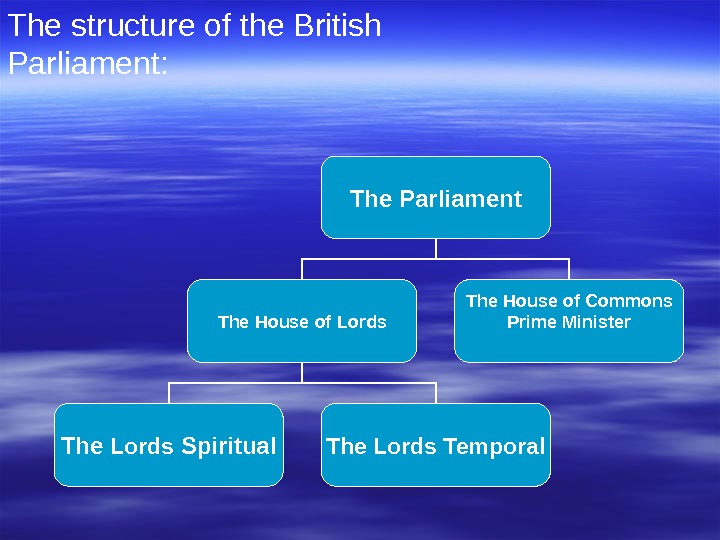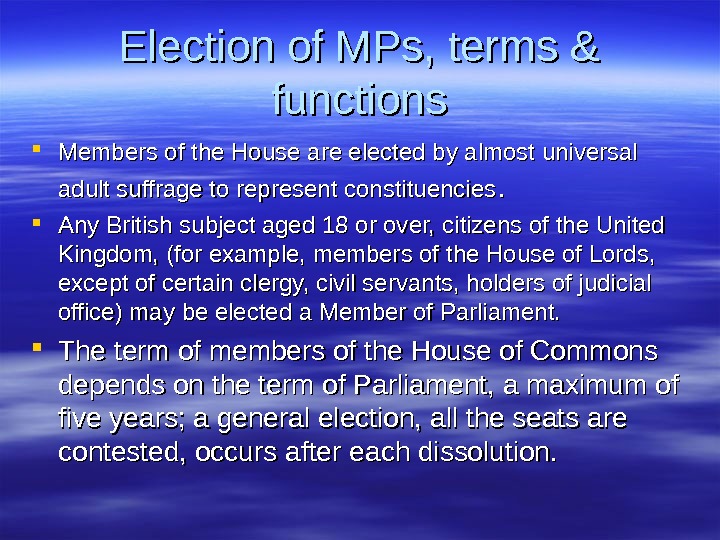Презентация presentation 1
















- Размер: 2 Mегабайта
- Количество слайдов: 15
Описание презентации Презентация presentation 1 по слайдам
 The Political system of Great Britain. . . The basis of the British parliamentary Democracy
The Political system of Great Britain. . . The basis of the British parliamentary Democracy
 Match the words from lists AA and BB A B to appoint a) a new law to revise b) the country to vote c) a bill to rule d) Prime — Minister to delay e) a programme to sign f) a government programme to pass g) the policy
Match the words from lists AA and BB A B to appoint a) a new law to revise b) the country to vote c) a bill to rule d) Prime — Minister to delay e) a programme to sign f) a government programme to pass g) the policy
 THE MONARCH THE GOVERNMENT PARLIAMENT THE PEOPL
THE MONARCH THE GOVERNMENT PARLIAMENT THE PEOPL
 The structure of the British Parliament: The Parliament The House of Lords The House of Commons Prime Minister The Lords Spiritual The Lords Temporal
The structure of the British Parliament: The Parliament The House of Lords The House of Commons Prime Minister The Lords Spiritual The Lords Temporal
 thethe Cabinet 20 20 ministers the Prime Minister Non-Cabinet Ministers. THE GOVERNMENT chooses David Cameron
thethe Cabinet 20 20 ministers the Prime Minister Non-Cabinet Ministers. THE GOVERNMENT chooses David Cameron
 The Cabinet is the basis of the government; its members consist of the most important ministers who are selected by the Prime Minister. The members of the Cabinet are 23, much of their work being carried out in Committee The Cabinet determines, controls and integrates the policies of the government. The Cabinet meets in private and its deliberations are secret, collective responsibility is assumed for all decisions taken.
The Cabinet is the basis of the government; its members consist of the most important ministers who are selected by the Prime Minister. The members of the Cabinet are 23, much of their work being carried out in Committee The Cabinet determines, controls and integrates the policies of the government. The Cabinet meets in private and its deliberations are secret, collective responsibility is assumed for all decisions taken.
 THE GOVERNMENT to determine government policies; to be responsible for government policies; to coordinate government departments; to be responsible to the House of Commons;
THE GOVERNMENT to determine government policies; to be responsible for government policies; to coordinate government departments; to be responsible to the House of Commons;
 The Prime-Minister lives and works in the official residence, No. 10 Downing Street, London.
The Prime-Minister lives and works in the official residence, No. 10 Downing Street, London.
 PARLIAMENT about 650 elected MPs- makes laws; discusses political Problems Life peers Over 1 100 permanent, non-elected members; peers and life peers. Examines and revises bills from the House of Commons; can delay bills for one yearthe House of Commons the House of Lords
PARLIAMENT about 650 elected MPs- makes laws; discusses political Problems Life peers Over 1 100 permanent, non-elected members; peers and life peers. Examines and revises bills from the House of Commons; can delay bills for one yearthe House of Commons the House of Lords
 The House of Commons The supremacy of the British House of Commons was established in the early 20 th century. In 1909, the Commons passed the so-called «People’s Budget ”. ”. The House currently consists of 646 members, but the number of Scottish Members was reduced by the Scotland Act 1998.
The House of Commons The supremacy of the British House of Commons was established in the early 20 th century. In 1909, the Commons passed the so-called «People’s Budget ”. ”. The House currently consists of 646 members, but the number of Scottish Members was reduced by the Scotland Act 1998.
 Election of MPs, terms & functions Members of the House are elected by almost universal adult suffrage to represent constituencies. . Any British subject aged 18 or over, citizens of the United Kingdom, (for example, members of the House of Lords, except of certain clergy, civil servants, holders of judicial office) may be elected a Member of Parliament. The term of members of the House of Commons depends on the term of Parliament, a maximum of five years; a general election, all the seats are contested, occurs after each dissolution.
Election of MPs, terms & functions Members of the House are elected by almost universal adult suffrage to represent constituencies. . Any British subject aged 18 or over, citizens of the United Kingdom, (for example, members of the House of Lords, except of certain clergy, civil servants, holders of judicial office) may be elected a Member of Parliament. The term of members of the House of Commons depends on the term of Parliament, a maximum of five years; a general election, all the seats are contested, occurs after each dissolution.
 The Lords It consists of: Lords Temporal and Lords Spiritual. Lords Temporal are all members of the Peerage. Formerly, they were hereditary peers. Lords Spiritual are the senior clergymen of the Church of England — archbishops, bishops and abbots. Later under Henry VIII the abbots lost their positions in Parliament. All bishops continued to sit in Parliament, but now there are only the 21 most senior Lords Spiritual.
The Lords It consists of: Lords Temporal and Lords Spiritual. Lords Temporal are all members of the Peerage. Formerly, they were hereditary peers. Lords Spiritual are the senior clergymen of the Church of England — archbishops, bishops and abbots. Later under Henry VIII the abbots lost their positions in Parliament. All bishops continued to sit in Parliament, but now there are only the 21 most senior Lords Spiritual.
 The House of Lords Until the 19 th century — the House of Lords was superior to the House of Commons both in theory and in practice. Members of the House also controlled tiny constituencies, known as pocket boroughs The House of Lords now subordinates to the House of Commons. More recently, the Act of 1999 removed the automatic right of hereditary peers to sit in the Upper House (except of 92 on temporary basis. The Constitutional Reform Act of 2005 abolished the judicial functions of the Lords.
The House of Lords Until the 19 th century — the House of Lords was superior to the House of Commons both in theory and in practice. Members of the House also controlled tiny constituencies, known as pocket boroughs The House of Lords now subordinates to the House of Commons. More recently, the Act of 1999 removed the automatic right of hereditary peers to sit in the Upper House (except of 92 on temporary basis. The Constitutional Reform Act of 2005 abolished the judicial functions of the Lords.
 THE PEOPLE all men and women over 18; elect members of the House of Commons; there are about 650 constituencies in the UK with 60 -70, 000 electors in each of them; on electing day people mark an “X” beside the candidate they wish to be elected; in each constituency, the candidate with most votes wins;
THE PEOPLE all men and women over 18; elect members of the House of Commons; there are about 650 constituencies in the UK with 60 -70, 000 electors in each of them; on electing day people mark an “X” beside the candidate they wish to be elected; in each constituency, the candidate with most votes wins;
 The British Symbols
The British Symbols

